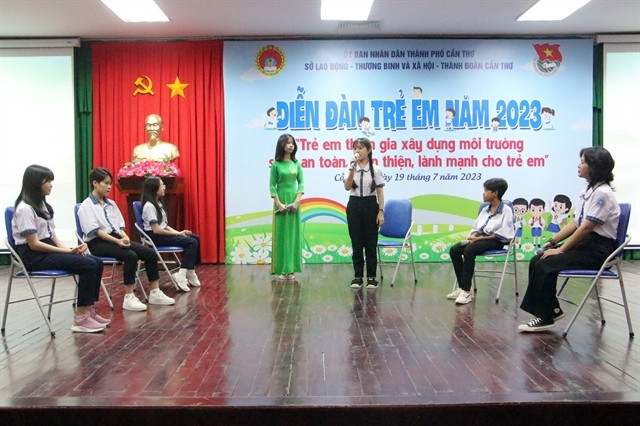 |
| Students explore the topic of protecting children online at the 2023 Children's Forum in Cần Thơ City. — VNA/VNS Photo Trung Kiên |
The Department of Child Affairs under the Ministry of Labour, Invalids and Social Affairs (MOLISA) emphasised the urgency of improving legal regulations on protecting children in the online environment, which is essential to safeguard children from the high risks posed by criminal groups on the internet.
Việt Nam has 24.7 million children, most of whom have access to the internet and digital devices from a very young age. The average age of Vietnamese children using the internet is nine years old, four years earlier than the global average.
Survey data from the MOLISA in 2023 shows that 89 per cent of children access and use the internet, with 87 per cent of them using it daily. Apart from time spent on studying, children spend average 5-7 hours per day on social media.
Health organisations recommend that children should only spend between two and three hours per day online.
Additionally, statistics from the Centre for Creative Initiatives in Health and Population revealed that nearly 36.5 per cent of children have encountered information and images related to violence on the internet and more than 13 per cent have been exposed to unwanted pornographic material.
There are numerous reasons for the high rate of child abuse on the internet, with a lack of knowledge and skills in safe internet usage being a major factor. Children often do not fully recognise the potential risks online and can easily become victims of scams, sexual exploitation and bullying.
N.V. H., a father of a 12-year-old daughter in Hà Nội’s Hà Đông District noticed that his daughter was spending a lot of time on her mobile phone. Upon checking her phone, he was shocked to find that she was involved in many inappropriate groups and chats on social media.
"She was in various chat groups discussing ways to skip classes and even more dangerously, some groups talked about adult-sensitive topics and shared explicit information and images. I had to take strong measures by banning her from using the phone for a while and explaining the dangers of participating in such groups," he said.
A national report on preventing harmful behaviour and evidence of child exploitation and sexual abuse online, showed that 23 per cent of children aged 12-17 had unintentionally seen sensitive images or videos online, while 5 per cent had received unwanted sensitive images.
Additionally, 8 per cent had received inappropriate comments about themselves and 2 per cent had been asked to discuss sexual topics against their will. However, 43 per cent of children did not report these incidents to anyone, believing that doing so would not resolve the issue.
Statistics from the Ministry of Public Security show that over the past three years, law enforcement nationwide has prosecuted more than 380 cases involving over 550 individuals for crimes related to child abuse and the distribution of obscene materials. Police have also blocked 30,000 websites with content that violates the law, including scams, harmful violence, child sexual abuse and defamatory material. Tens of thousands of harmful content links have been disabled.
The national child protection hotline, 111, has recorded 1,500 intervention support calls, including 419 reports of online child abuse.
Leo Thị Lịch, a standing member of the National Assembly's Council of Ethnic Minorities, noted that while internet coverage in mountainous and ethnic minority areas is increasing, children in these regions are not adequately protected from online exploitation.
A recent incident in Lục Ngạn District in Bắc Giang Province, involved a girl in the seventh grade who met and developed a relationship with a boy on social media, resulting in pregnancy and childbirth without her family's knowledge.
Safe environment for children
The Ministry of Information and Communications is drafting an amendment to the Government’s Decree 72 issued on July 15, 2013, on the management, provision and use of internet services and online information. The draft emphasises the responsibility to protect children and adolescents online as a crucial measure for internet development.
It includes additional regulations on social media management, limits on children's social media use, warnings about harmful content for children and the responsibilities of agencies, organisations and educational institutions in preventing harmful information and monitoring and protecting children online.
Nguyễn Thị Nga, Deputy Director of the MOLISA’s Department of Child Affairs, highlighted that Việt Nam has actively built and perfected the legal system to protect children online. This includes Decree No. 56/2017/ND-CP issued on May 9, 2017, detailing certain provisions of the Law on Children; Decision No. 830/QD-TTg issued on June 1, 2021, approving the programme to protect and support children for safe and creative interactions online; and Directive No. 23/CT-TTg issued on May 26, 2020, on strengthening measures to ensure children's rights and protect children.
Nga said it is essential to enhance education and raise awareness among children about online safety so that they have the knowledge and skills to protect themselves from online risks. Authorities, schools and families need to collaborate to guide children in using the internet safely and healthily.
The expert emphasised the need for close cooperation between agencies, organisations and communities to create a safe online environment for children. Technology companies should develop tools and software to monitor and filter inappropriate content.
Creating healthy and creative online playgrounds for children is crucial. Given the increasingly complex and risky online environment, building a safe and healthy cyberspace for children is a top priority that requires the collective effort of society, she said. — VNS